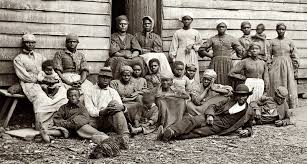I have been tragically remiss in the planning for my documentary on the New Economy, which is a restructuring of our economy based on the wellbeing of people, planet and prosperity. The foundation of our current economy is the slave industry and the stealing of Native American lands. It seems critical to me that since I am covering the New Economy that I cover the sordid history of the current economy as well as what is being done currently to make some kind of amends. African Americans and Native Americans are still paying dearly for the sins of our past.
Enslaved people and their families were bought and sold as commodities to provide labor for in cotton, rice, sugar, and construction industries. They were also used as collateral for mortgages on plantations, which put more capital into the economy than sales from crops harvested by the enslaved workers. State-chartered banks pooled debt generated by slave mortgages and repackaged it as bonds promising investors annual interest finding buyers in domestic and foreign markets. 
Sociologist Matthew Desmond believes that today’s capitalism of stunning disparities ignores the fact that “slavery didn’t just deny black freedom but built white fortunes, originating the black-white wealth gap that annually grows wider.” It’s worthy to note that the original site for Wall Street was built by the enslaved to be the city’s first organized slave auction.
In addition to the lingering effects of slavery on today’s inequities for blacks in wealth, education, housing, healthcare, and voting rights is the extension of slavery through incarceration. The 13th Amendment is credited with ending slavery but it made an exemption for those convicted of crimes. According to Bryon Stevenson, Director of the Equal Justice Initiative, “laws governing slavery were replaced with Black Codes governing free black people—making the criminal-justice system central to new strategies of racial control”.
These strategies intensified whenever black people asserted their independence resulting in “crimes” of vagrancy, loitering, being a group of black people out after dark, seeking employment without a note from a former enslaver. They have been updated today as “driving while black”, sitting in a coffee shop while black, sleeping while black, etc. Those who went to prison in the past labored in brutal conditions for businesses and farms and today prisoners continue to provide unpaid labor for private businesses. This country’s incarcerated population of 2.3 million people is disproportionately black — 38 percent versus 13 percent in the overall population — and social researchers describe our prison system and its supply of “free labor” as a new form of slavery.
Native Americans
Native American relationship with nature permeated every aspect of life from spirituality to making a living and led to a different way of seeing the world. They viewed land as something that was to be used communally by all the members of a tribe. There was no idea among the Indians that land was something to be divided up, sold, and owned by individuals. They lived on the land, held certain lands sacred and farmed and hunted on the land.
They made us many promises, more than I can remember, but they never kept but one; they promised to take our land, and they took it. Chief Red Cloud
The treatment of Native Americans by Europeans, US government and religious institutions has been bent on eradicating them and their culture. Historically, Native Americans have experienced massacres, terror, systematic military occupations, removals from their lands, the separation of children from their families to live in military-like boarding schools, and the breaking up of whatever land (reservations) they had into small allotments with the surplus sold to non-Native Americans. A visual time-lapse map on the loss of 1.5 Billion acres of Native American lands. Estimates for the decline of Native American population range from 50 to 80 percent.
Native American lands were stolen for settlement, military occupation, exploitation of natural resources including mining, timber, gas and oil. I could not find a good source for what a monetary value of the stolen lands and their resources would be today. It has to be in the trillions. Today, the government holds more than 100,000 leases to manage about 56 million acres of tribal lands and, more than half of the land within reservation boundaries across the United States is privately held by non-Indians.
To wrap up, it is the use, abuse and trade of human beings as commodities not people and the usurpation and control of Native American culture and lands that not only fueled the US economy from day one but the principles and values embedded in this foundation live on in its advancement.
Next up, I’ll take a look at what is being accomplished today to address the tragedies upon which our economy is founded through reparations for descendants of enslaved people and the reclaiming of Native American lands.
